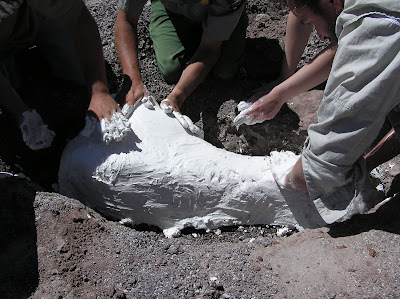We head out to the field with topographic maps, a GPS unit, and colored pencils. We use the colored pencils to color the different rock units in on the map wherever we find them. Here is Katie studying the map as it relates to the surrounding terrain.
Mapping requires a lot of guesswork, especially where fluvial (stream or river) systems are concerned. Streams migrate over time, so a sand deposit formed in a streambed might be thin, it might change position as you move up into younger rocks, it might disappear entirely for a while. Some questions we might try to answer with mapping include: are the blue mudstones in the south area the same as those in the north area? Do they connect? Could they have been formed at the same time? Take a look at this picture. Is the sandstone I was standing on the same as the sand in that white layer in the distance? The only way to be sure is to walk it out. What if erosion has cut away too much to allow you to follow the sandstone all that way? You will just have to make your best guess.
While walking around we've encountered many interesting things on a smaller scale. Here's a picture of what are likely some fossilized burrows in the sandstone:
If you look closely you can see the horizontal layers in the rock. These are layers of sand and silt deposited by different stream conditions over time. After they were deposited, some animal made burrows in the streambed, and sand filled them in. The burrows stand out slightly from the rock because the sand is more resistant to weathering than the silty layers are.
I've also done some more prospecting and excavating. Here's a picture of some "arm" bones from a Triassic reptile…
Below see outlines of the bones (black) and the part I first spotted sticking out of the sand (white):
It has taken me a few days to learn to spot bone. Some day I'll post a test for you all: I'll take a picture of a flat with bits of all kinds of stuff on it, and you can see if you can find the bone.
I also found the end of what turned out to be the top half of a phytosaur skull sticking out of the flat, and this was excavated over the past couple days. Here it is during excavation.
We had to uncover enough to find out basically where the bone was, but other than that we tried to leave a layer of mudstone around it to protect the bone, which was a bit crumbly. Then we put the plaster jacket on:
We were able to flip the jacket upside-down without all the mudstone and bones falling out, despite it weighing an estimated 300 pounds. Later the preparator will carefully dig in and remove the bone fragments, gluing them together. When he's done the skull should look like the top portion of this one:
One of the nicest things about working out here is just the beautiful scenery. Here's where I spent the last couple of days:
Not bad!










1 comment:
I'm so happy you're enjoying yourself out there...
You know Jo, I was reading along and was really going to try to pretend to be completely interested in all the big words and such, but I've decided I can't even go that route.
Having said that, I DID spot the word 'reptile' and that kinda turned my key for obvious reasons.
Gunther is doing well by the way... growing rapidly now. He has taken to digging his nose into the soft stones and practically standing on his head for whole segments of time. What a guy.
Be careful ... it's a desert out there!
Post a Comment